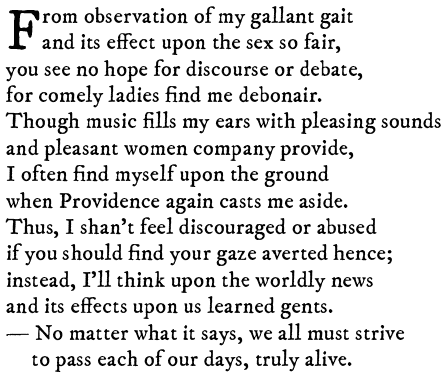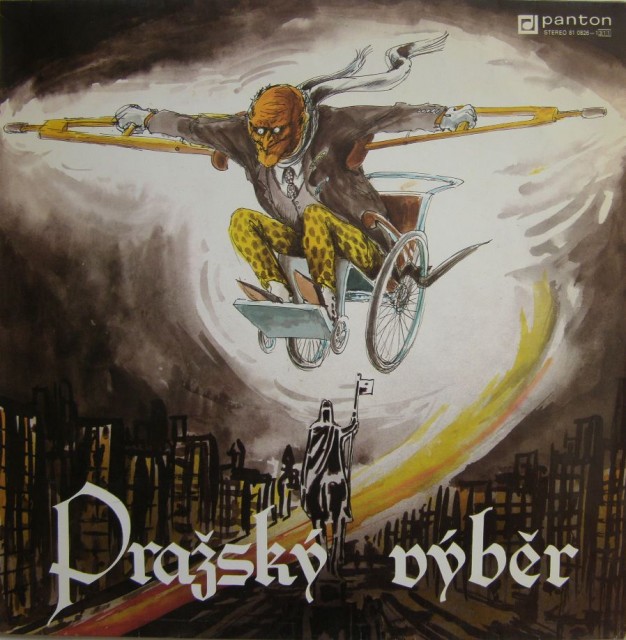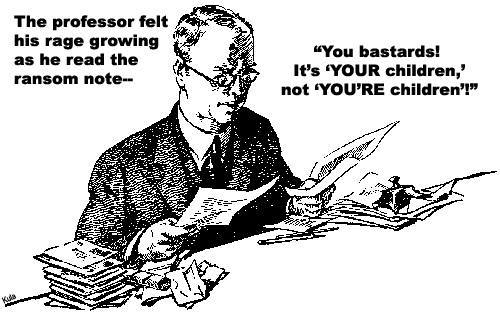… with bonus cheesecake.
Category: Culture and anti-culture
Today’s quote
His films have an inner clarity and beauty that few others achieve. Yet they are frequently wrapped in mystery, ambiguity, and confusion. And purposely so. Miyazaki not only fills his films with the treasures of intellectual study, he also refuses to over-clarify them. As he said of his epic Princess Mononoke, “I made this film fully realizing that it was complex…If one depicts the world so that it can be figured out or understood, the world becomes small and shabby.”
Update: Bonus quote:
There is a parallel universe where Hayao Miyazaki directed The Hobbit movie. Maybe one of its inhabitants can lend me a DVD.
Today’s literary classic
“One morning, upon awakening from agitated dreams, Kitty White found herself, in her bed, transformed into a small, mouthless cat.”
There’s also a Harlan Ellison story there, but you knew that already.
Name that tune
These are the lyrics to a certain over-familiar song rewritten as a sonnet. Can you identify the original? Here’s a hint the answer. There are more sonnets here.
(Via Fillyjonk.)
The futures of the past
GorT recently found a Popular Mechanics list of the 50 greatest “sci-fi” television shows. Most of the shows listed were aired after I quit watching teevee, but there are a few I can comment on.
41. Battle of the Planets — I bought the first disc of Gatchaman to fill out an order a few years ago. It’s of great historical importance in the development and popularization of anime and all that, but Gatchaman Crowds is better.
36. Buck Rogers in the 25th Century — Dumb, but it had what’s-her-name in spandex during the first season.
35. Cowboy Bebop — A great classic, I suppose, but I lost interest after a few episodes. Yoko Kanno’s soundtrack almost redeems it. My recommendation: skip the DVDs and track down the CDs.
31. Lost in Space — A dumb show containing the germ of a better one. Keep the Dr. Smith and the robot, add Will Robinson to tweak Smith’s vestigial conscience and generate plots, dump the rest of crew, and you’d have a pretty good sf comedy. The actual show was watchable only when Smith was onscreen with the robot.
30. Battlestar Galactica (1978-79) — I watched the first episode or two. I was embarrassed for Lorne Greene.
27. Red Dwarf — I never saw any of this, but I read a couple of the books. They’re okay, but Douglas Adams did that sort of thing better.
26. Ghost in the Shell: Stand Alone Complex — I haven’t watched all of it, but what I’ve seen is very good. And there’s Yoko Kanno’s music as well.
11. Firefly — I watched a couple of episodes while visiting friends a few years ago. I might watch the rest sometime.
10. The Outer Limits — When it was good, it was great, or so I thought when I was eleven. I haven’t seen it since.
8. Neon Genesis Evangelion — What the hell is this doing in this list at all, let alone in the top ten? I watched the first disc of Anno’s neurotic fantasy, and I’d like those two hours of my life back. The only character who isn’t repellent is the penguin.
7. The Prisoner — I never saw the final episode. I have Thomas Disch’s novelization somewhere in my piles of books. Someday I may read it.
6. Star Trek (the original series) — A favorite when I was young, despite my contempt for Kirk.
5. The Twilight Zone — Another favorite. Unfortunately, it was seldom broadcast at a time when I could watch it.
1. Dr. Who — I saw a few episodes during the Tom Baker era. It was okay.
The Popular Mechanics article is missing a qualification: all the shows listed were broadcast in America. A true list of the best science fiction shows of all time broadcast anywhere would have to include these:
• Shin Sekai Yori — What are the consequences of a change to human nature? What is human?
• Serial Experiments Lain — Cyberpunk meets ontology; Teilhard’s noösphere gone wrong.
• Dennou Coil — Augmented reality and kids. Imagine Ghost in the Shell as done by Miyazaki.
• Shingu — A friendly town with a secret, kids with strange powers and invaders from space. And they’re all genuinely likable, except for the killer robots.
And perhaps these:
• Oh! Edo Rocket — Aliens beasts and rockets in 19th-century Edo, with repression and corruption, slapstick and horror, and a faux Glenn Miller soundtrack.
• Kaiba — You can take a person’s memories from one body and put them in another. What could possibly go wrong?
• Mouretsu Pirates — High school girls and space pirates. It was directed by Tatsuo Sato, the man responsible for Shingu. As with Shingu, the story is good but the ultimate value of the show is in the characters whom you enjoy spending time with.
• Jinrui wa Suitai Shimashita — The twilight of the human race, with fairies.
… and probably several others I’ve forgotten or haven’t seen. There are undoubtedly worthy shows from other countries as well that I’ve never heard of.
Useful advice
No laughing matter
Comic Sans might be the least-loved of all typefaces, but I think it would be an appropriate font for certain uses. Government documents, for instance.
One of the candidates for greatest album cover of all time. The music is pretty good, too.
More nonsense:
Feeling a little Puckish
I found a complete performance of Balanchine‘s A Midsummer Night’s Dream. If you remember the play, you can follow the story pretty well, though Balanchine made many changes in adapting it. Even if you haven’t read Shakespeare, you can enjoy the spectacle, and there’s always the music.
Frederick Ashton also choreographed the play in The Dream. In his version, the transformed Bottom dances on pointe for added grotesquerie.
A world full of Walters
 The results of the Liebster project are in, and there are some interesting data uncovered about these three very different people. The Brickmuppet played trombone; Robbo was nearly run down in a parking lot by Antonin Scalia; Topmaker likes Ian Hunter and Nathaniel Hawthorne. But all three did mention the same name somewhere in their responses.
The results of the Liebster project are in, and there are some interesting data uncovered about these three very different people. The Brickmuppet played trombone; Robbo was nearly run down in a parking lot by Antonin Scalia; Topmaker likes Ian Hunter and Nathaniel Hawthorne. But all three did mention the same name somewhere in their responses.
Prickly pears and whimpers
In the Wikipedia article on Eliot’s “The Hollow Men,” I came across this note:
References range from film (Apocalypse Now, Southland Tales, Waking Life) to video games (Fable II, the Halo series, and Metal Gear Solid 2: Sons of Liberty)[citation needed], to Japanese literature (the novels of Haruki Murakami) and anime (the last episode of Highschool of the Dead), to American television shows (30 Rock, Frasier, The Big Bang Theory, Northern Exposure, Dexter, Mad Men, The X-Files [“Pusher” episode], and Dollhouse [“The Hollow Men” episode]).
What I’ve read about Highschool of the Dead sounds loathsome and I have no intention of ever watching it. But I am curious: does “The Hollow Men” really turn up there?
I can sympathize
By the way, Bill Watterson dropped by for a few minutes.
“I lieb’ ya, I lieb’ ya, baby, I lieb’ ya. Now lieb’ me alone”
Thank you, I think, Josh and Professor Mondo, for giving me the “Liebster Award.” Twice. It’s a great honor and all that. It’s also a fair amount of work. I’ll try not to groan too loudly as I comply with the terms.
This award has been floating around the internet for several years, and the rules have mutated over time. These are what I’m going by today:
 The Quasi-Official Rules of the Liebster Award
The Quasi-Official Rules of the Liebster Award
If you have been nominated for The Liebster Award AND YOU CHOOSE TO ACCEPT IT, write a blog post about the Liebster award in which you:
1. thank the person who nominated you, and post a link to their blog on your blog.
2. display the award on your blog — by including it in your post and/or displaying it using a “widget” or a “gadget”. (Note that the best way to do this is to save the image to your own computer and then upload it to your blog post.)
3. answer 11 questions about yourself, which will be provided to you by the person who nominated you.
4. provide 11 random facts about yourself.
5. nominate 5 – 11 blogs that you feel deserve the award, who have a less than 1000 followers. (Note that you can always ask the blog owner this since not all blogs display a widget that lets the readers know this information!)
6. create a new list of questions for the blogger to answer.
7. list these rules in your post (You can copy and paste from here.) Once you have written and published it, you then have to:
8. Inform the people/blogs that you nominated that they have been nominated for the Liebster award and provide a link for them to your post so that they can learn about it (they might not have ever heard of it!)
*****
Eleven noteworthy facts about myself that I haven’t mentioned before? This might be difficult.
Continue reading ““I lieb’ ya, I lieb’ ya, baby, I lieb’ ya. Now lieb’ me alone””
Odds & ends
A couple of commencement addresses:
I’m trying to convince myself that I can get along perfectly well with an extension tube and I don’t really need a macro lens. Well, maybe.
Extracurricular reading
I have another new toy, and I’m going to continue to be scarce here for a while longer while I figure it out. While I’m gone, you might want to drop in on Josh, who’s blogging his way through the alphabet. I particularly like his entries for G, J, R and S. There’s also this:
And don’t get me started about clown masses. If you want proof that Satan is real…
Update: Read also Eve Tushnet on Last Call.
You can also watch some fine unlicensed anime on YouTube, such as Kenji Nakamura‘s first and best series, Mononoke
(I wonder if Tushnet has see any anime beyond Tokyo Godfathers. I’d really like to see what she can find in such works as Mononoke and Serial Experiments Lain.)
Did we land, or were we shot down?
Miscellaneous links and nonsense:
David Bentley Hart, from the May 2014 First Things:
Journalism is the art of translating abysmal ignorance into execrable prose.
A look at brilliant, psychotic Joe Meek, who changed the sound of music.
Stereo pictures from WWI. A couple of notes: stereograms made for hand-held viewers use the parallel method of viewing, not the crossed-eye. I.e., the right eye focuses on the right image, the left eye on the left. It is possible to free-fuse the images, though it is easier done than explained. Let your eyes relax and drift apart until the images of a well-defined region in the pictures, such a the bright sky through the roof in the above image pair, start to overlap. Focus on that region until the images snap together, and you should then be able to see the entire scene in perspective. (You’ll need to sit back at least two feet from the monitor if you want to see the full-size images at the link in stereo.)
One kind of efficiency
I’ve been skipping around in The Stuffed Owl: An Anthology of Bad Verse recently. Here’s a bit of practical advice from Ralph Waldo Emerson.
Earth, crowded, cries: “Too many men!”
My counsel is, kill nine in ten,
And bestow the shares of all
On the remnant decimal.
Most of the verse is subtler than that — if an encomium to the London sewer system, for example, can be called “subtle.” If you all are very good, I won’t quote any more of it.








